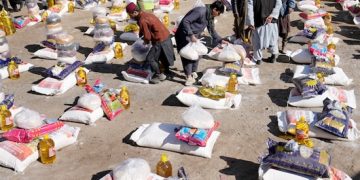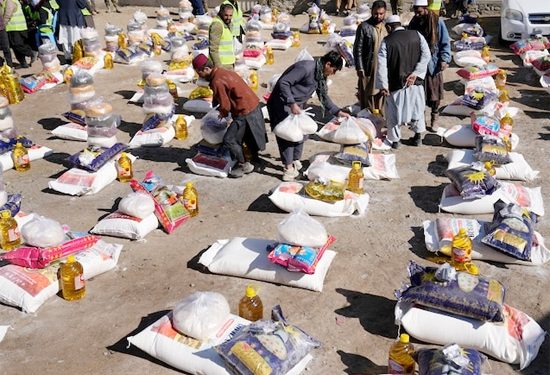Washington Post
President Biden’s recent decision to seize the frozen reserves of the central bank of Afghanistan came as a shock to starving Afghans battling a harsh winter coupled with a crippled economy. It has led to severe withdrawal limits at private banks, further squeezing the pocketbooks of average people. Imagine dissolving the U.S. Federal Reserve, blocking the savings of all Americans and implementing a weekly withdrawal limit of less than $400.
Biden’s intention to divide the money between survivors of the 9/11 attacks and, nonspecifically, humanitarian aid to “benefit” the Afghan people, is as confounding as it is cruel. A year ago, the United States was trying hard to preserve and strengthen institutions in Afghanistan like the central bank. Now, the Biden administration is knocking the legs out from under the country’s banking sector, thwarting the economy and leaving Afghans like me unable to access our savings.
Since the disastrous pullout of U.S. troops in August, much of the criticism of American actions has centered on their leaving Afghans to the mercy of the Taliban. But as this decision demonstrates, the legacy of U.S. abandonment goes much deeper. After the withdrawal, international aid that the country came to depend on dried up under U.S. pressure. School, road and utility projects started during the occupation were abruptly halted, leaving thousands unemployed.
The pattern of costly and damaging starts and stops is nothing new. I remember vividly in 2011 meeting U.S. government officials at USAID offices in Kabul made of cramped cubicles inside tight cargo containers. At the time, I was leading the implementation of large power projects at the national power utility of Afghanistan. USAID was promoting the idea of providing electricity to southern Afghanistan from Central Asian countries via imported electricity passing through the rough terrain of more than 500 miles.
We, the Afghan technical team, pushed for indigenous generation via renewable energy sources. But the Americans wanted a quicker fix in the misguided hope that by extending power line pylons, people would refrain from supporting the Taliban.
The $861 million project became bogged down in paperwork, delays, cancellations, and numerous corruption and embezzlement scandals. Extravagant salaries and benefits were provided to American consulting firms to supervise the project. Still, the project moved forward, promising to bring electricity to the people of five provinces in Southern Afghanistan. The project was finally on the verge of completion in August — when the republic’s government fell, the Taliban took over, and the United States withdrew from Afghanistan.
The U.S. government suspended this and all infrastructure projects funded by the USAID, the World Bank and the Asian Development Bank on Aug. 15. These projects provided a livelihood to hundreds of thousands of Afghans. Most of these projects had a progress rate of more than 80 percent, colleagues in the Ministry of Finance told me. Billions of dollars were spent to reach this stage and then stopped overnight.
As a parting shot to the new Taliban-led government, which the United States considers illegitimate, the U.S. government imposed punishing sanctions that throttled the economy. The impact has gone beyond the widespread starvation that has left 97 percent of the population unsure where their next meal will come from. Seven billion dollars of the bank’s funds were frozen, leading to instant consequences for everyday Afghans. For instance, when my father wants to withdraw cash, he has to register his name four days in advance and stand in a queue for hours — once, more than six hours. When it’s his turn, he is permitted to withdraw the equivalent of $400. That sum won’t cover regular household expenses like rent, groceries, utility bills and medicine.
International aid that accounted for 75 percent of the previous government’s spending was also suspended. The United States ordered partner agencies, including the World Bank, International Monetary Fund and the Asian Development Bank to halt the flow of aid to Afghanistan. Out of fear of retribution by the United States or to maintain the alliance, European countries also blocked their support.
Medical supplies have stopped flowing to health-care facilities, and doctors and nurses at hospitals aren’t getting paid. Caesarean sections are being done by cellphone flashlight. A hospital had to deliver the babies of five mothers with just one pair of gloves. Many pregnant mothers and newborns, perhaps thousands, have lost their lives because of this deliberate obstruction of aid to health facilities.
The World Bank blocked five months’ salary of 10,000 Afghans who worked on Afghanistan Reconstruction Trust Fund projects. My colleagues told me heartbreaking stories of hunger and hardship that these employees’ families had endured. The World Bank also suspended the construction of 600 schools, including girls’ schools in rural Afghanistan that were nearly completed, and 9,000 projects of the Afghanistan Citizens’ Charter Program — primarily in irrigation, renewable energy and transportation. Some 124,000 Afghan women in 13,000 communities led and monitored these projects; they are now abandoned.
Such actions by the United States send a bitter signal to 38 million Afghans. The majority of Afghans, especially in rural areas, didn’t know about the 9/11 attacks and why the United States invaded and bombed them for 20 years, but they do feel the hunger of 23 million of their fellow citizens and the pain of 3.2 million malnourished children younger than 5, of which 1 million could starve to death by the end of the winter.
“We must pull the economy of Afghanistan back from the brink,” António Guterres, the United Nations Secretary General, told the Security Council last month. “This means finding ways to free-up frozen currency reserves and re-engage Afghanistan’s Central Bank. International funding must be allowed to pay the salaries of public-sector workers.”
In seizing the central bank funds, Biden issued a statement that his plan was “designed to provide a path for the funds to reach the people of Afghanistan, while keeping them out of the hands of the Taliban and malicious actors.” But this concern can be addressed in various ways; members of the Supreme Council of the central bank have suggested having monitored and conditional access to reserves. The transactions can be verified electronically and through one of the international auditing firms currently operating in Afghanistan.
The way forward is to simply allow the Afghan economy to breathe by lifting sanctions and gradually returning the central bank reserves that belong to the people of Afghanistan. This will prevent the collapse of the banking sector. Commercial activity will resume.
The United States should also allow development partners like the World Bank and Asian Development Bank to complete unfinished infrastructure projects. Implementing them is critical to helping rural communities flourish and earn their livelihoods instead of waiting in their mud homes or tents to get a weekly sack of flour and beans from humanitarian organizations.
The resumption of irrigation, energy and transport projects will more likely bring an end to the crisis without the need for more humanitarian assistance. Lifting sanctions on commercial activity and completing unfinished development projects will be sufficient for the economy to recover. This would be in line with American values. It would do justice to the $2 trillion in American taxpayers’ money spent on the war in Afghanistan.





